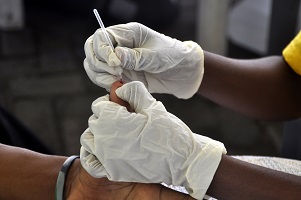Leveraging weather forecasts to fight malaria

Related topics
Environment & climate action Innovation International cooperation Societal Challenges France Germany Spain United Kingdom Environment Ghana Kenya Malawi South Africa Senegaldate: 22/04/2015
Project: Quantifying Weather and Climate Impacts ...
acronym: QWECI
See also: CORDIS
World Malaria Day - 24 April 2015
Can seasonal weather forecasts be used to signal the severity of outbreaks of deadly diseases, such as malaria? Scientists across the world have been investigating how to do so, encouraged by the increasing accuracy of weather forecasting and growing scientific knowledge about the local effects of climate change.
Malaria, for example, killed about 580 000 people in 2013, most of the victims African children. Malaria is caused by Plasmodium parasites, spread to people through the bites of infected Anopheles mosquitoes, called ‘malaria vectors’. As mosquitoes need pools of water to lay their eggs, more rain would imply more mosquitoes would be around to transmit the disease to more people.
Early warnings about a possible increase in malaria cases in an area, made possible by forecasts of a particularly long rainy season, could help save lives – governments could decide to step up insecticide spraying programmes and deploy more health workers where needed.
The EU-funded QWeCI project has advanced research in the field by developing a new prediction model that can be used to simulate seasonal disease patterns for malaria and Rift Valley fever. Rift Valley fever is transmitted by different species of mosquito and mainly affects livestock.
By the end of the project in July 2013, the researchers had also demonstrated how the model might be used to provide input for an early warning system for the two diseases.
“QWeCI significantly moved forward scientific understanding of the linkages between climate, environment and health – important to the aim of reducing the risk from vector-borne diseases in sub-Saharan Africa under both current and future climate conditions,” says project coordinator Andy Morse of the University of Liverpool in the UK.
He adds: “It is very flexible model. It could also be used as a building block, a kind of toolkit, for developing models for other vector-borne diseases.”
Fruitful partnerships
QWeCI brought together researchers in Europe with counterparts in Ghana, Malawi, Senegal and South Africa. Pilot field studies were carried out in Senegal, Ghana and Malawi.
In Ghana, team members studied how malaria emerges during the rainy season, is transmitted and spreads. They also examined the role of climate change in the severity of the disease. In Malawi, researchers collected statistics on malaria from hospitals, and in Senegal they studied climate, water quality, vegetation, land use and veterinary factors involved in malaria and Rift Valley fever.
These studies helped the researchers create medical databases. They also developed an atmospheric database with information on the geographical distribution of pathogens and potential climate factors. The team also produced disease risk maps for the areas studied in Senegal, Ghana and Malawi. Local specialists can use the maps to monitor disease outbreaks and communicate risk information to decision makers.
Feedback from the project’s African partners helped to tailor a demonstration concept of an early warning system to the needs of end-users in the target areas.
The project’s research was used to improve a disease database at the Liverpool-based National Consortium for Zoonosis Research. QWeCI also established a new atmospheric database and web-based portal run by the University of Cologne. A climate-model portal, which allows users to downscale information from a global model (100+ km resolution) to regional or local scales, was established by the Santander Meteorology Group, a project partner based in Spain. The information is being used for further research into practical applications for disease prediction.
The team also made recommendations on the remaining steps needed to design and implement an effective early warning system for vector-borne diseases in Africa.
“QWeCI has shown African policymakers that disease early warning systems can be implemented and could be made to work.” says Morse. “Most importantly, it has connected, supported and inspired the next generation of African and European scientists who made key inputs to the project.”
